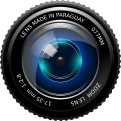ISO Settings
One of the key factors in low light photography is the ISO setting. ISO measures the sensitivity of the camera's sensor to light. The higher the ISO the more sensitive the camera's sensor becomes to light, allowing you to capture images in low light conditions. However increasing the ISO also increases the amount of digital noise in the image. To balance image quality and the ability to capture images in low light conditions it's important to choose the right ISO setting.
In general, you should start with an ISO setting of around 400 and adjust it based on the lighting conditions. If the light is very low you may need to increase the ISO to 800 or 1600. Keep in mind that the higher the ISO, the more digital noise will appear in the image. To minimise digital noise try to keep the ISO as low as possible while still being able to capture the image in low light conditions.
Aperture Settings
Another crucial element in low light photography is aperture. The size of the hole in the lens through which light enters the camera's sensor is referred to as the aperture. The more light that enters the camera through the aperture the easier it is to take pictures in low light.
The optimum aperture to utilise in low-light situations is one with a wide opening such f/2.8 or f/1.8. This lets the most light into the camera and will help you take pictures with a shallow depth of focus which may give your low light photos a unique touch.
Shutter Speed Settings
The duration of time the camera's sensor is exposed to light is referred to as the shutter speed. A slower shutter speed can be employed in low-light situations to let more light reach the camera's sensor, but it also raises the possibility of camera shake and fuzzy photographs. When employing a slow shutter speed it's crucial to utilize a tripod or another stabilizing device to prevent camera shake and fuzzy photographs.
Shutter speeds of 1/60th of a second or less are typically regarded as slow, whereas shutter speeds of 1/125th of a second or more are regarded as fast. It's ideal to start with a shutter speed of 1/60th of a second in low-light situations and then modify it as necessary.
Focus Settings
When photographing in low light, focus is equally crucial. It might be challenging for the camera's focusing mechanism to lock onto a target in dim lighting. You may utilise the camera's live view mode or switch to manual focus to aid the focus in dim lighting.
In live view mode, the camera focuses on the subject using the screen rather than the focusing mechanism, which can be more precise in dim lighting. Manual focus involves adjusting the focus by hand, which can be more precise in dim lighting.
White Balance Settings
White balance refers to the camera's ability to accurately reproduce the colors in an image. In low light conditions, the camera's white balance system can become confused, leading to images with a yellow or orange cast. To avoid this you can adjust the white balance manually or use the camera's automatic white balance system.
In general, it's best to use the camera's automatic white balance system in low light conditions. However if the automatic white balance system is not producing accurate results you can adjust it manually. The most common white balance presets including daylight, shade, tungsten and fluorescent but you can also create a custom white balance setting to get the most accurate results.
Conclusion
Low light photography can be challenging, but with the right camera settings and techniques, you can capture stunning images even in the dimmest conditions. By understanding the key factors of ISO, aperture, shutter speed, focus, and white balance, you can take your low light photography to the next level.
So next time you find yourself in a low light situation, remember these key camera settings and techniques, and you'll be well on your way to capturing beautiful images.

